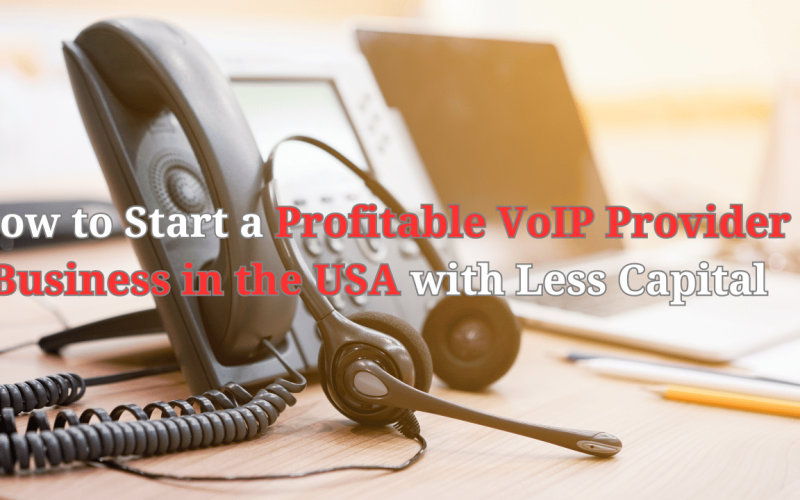If you want to start a profitable Voice over Internet Protocol (VoIP) provider business in the USA, you will be happy to know you can do it for less start-up capital.
The 2022 Global Voice Over Internet Protocol (VoIP) Market Size reached a value of USD 40.2 billion, with projections indicating that the global VoIP market is poised to grow to USD 108.5 billion by 2032.
Thanks to the industry’s rapid growth, you have a compelling opportunity to launch a VoIP provider business in the USA.
With low overhead costs and the ability to operate online, it’s possible to break into this industry without deep pockets.
Read Also: How To Start A Mold Remediation Business
How to Start a Profitable VoIP Provider Business in the USA with Less Capital
Follow these steps to start a profitable VoIP provider business in the USA:
1. Conduct Market Research
The first step is researching the VoIP provider landscape to identify an ideal target market and position your brand appropriately.
Determine which customer segments are currently underserved and what their needs are.
However, small businesses and remote teams may want basic service with fewer frills.
Consider specializing in an industry vertical like healthcare, finance, government, etc.
Also, research competitors and their pricing. Look for gaps you can fill or areas where you can compete on better rates or packages.
In addition, map out the regulatory environment. While VoIP is less restricted than traditional telephony, some state and federal regulations still apply.
Overall, thorough market research will point you toward the right positioning and inform branding, features, and pricing.
2. Choose a Business Structure
Most solo entrepreneurs start VoIP providers as limited liability companies (LLCs) in the USA.
This separates your personal assets from the business for liability protection. LLCs have simple tax and compliance requirements.
You avoid double taxation by filing taxes through your personal returns. Costs to form an LLC vary by state but typically range from $50-$500.
Alternatively, you can structure it as a C-corp or S-corp, but taxation is more complex. Consult an accountant or attorney to choose the best legal structure.
3. Analyze Your Funding Options
Launching any business requires capital. With careful planning, you can bootstrap a VoIP provider with:
Personal Savings – Avoid taking on business debt by funding the early stages from your own savings. Set realistic startup and operating budgets.
Credit Cards – Use rewards cards or 0% intro APR offers to finance initial expenses. Payback quickly to avoid interest charges.
Rollover 401(k) – You can rollover funds from a previous employer’s 401(k) plan without tax penalties. Contributing it to your business helps avoid debt.
HELOC Loans – Unlocking home equity via a HELOC (home equity line of credit) converts real estate into working capital. Be cautious of risking your home as collateral.
SBA Loans – Small Business Administration 7(a), microloans, and Community Advantage loans provide financing for qualified business owners.
Angel Investors – Pitch to high net-worth individuals who provide startup capital in exchange for equity. Ideal for expanding an established business.
Bootstrapping exercises financial discipline while retaining full ownership early on. Once revenue starts flowing, you can secure traditional financing like bank loans or lines of credit.
4. Obtain Required Licenses and Permits
While VoIP providers aren’t as heavily regulated as traditional telcos, some licenses and permits are still required:
- Business License – Register your business name and entity with the state.
- Sales Tax ID – Obtain a tax ID number to collect and remit state sales tax.
- FCC Registration – Register with the Federal Communications Commission if offering interstate calling.
- E911 Service – Sign up for Enhanced 911 service to route emergency calls.
- Phone Numbers – Acquire DID phone numbers through a SIP trunking provider.
- Operating Permits – Some cities require business operating permits for service providers.
Research requirements in your state and municipality to ensure full compliance.
5. Choose VoIP Technology Stack
A core startup task is mapping out your VoIP technology architecture. As an independent provider, you can piece together your own custom stack. Key elements are:
PBX Software – The core business phone system (e.g. FreePBX, 3CX, Switchvox). Options range from open source to paid.
SIP Trunking – Provides virtual “lines” for outbound calling over the internet (look for metered plans to reduce costs).
Phone Numbers – Acquire local or toll-free numbers via a SIP trunking service for maximum flexibility.
Call Routing – Route calls intelligently based on time, department, location, etc.
Voicemail – Enable voicemail-to-email and other advanced features.
CRM Integration – Connect your PBX to your customer relationship management platform.
Billing Platform – Usage-based billing for metered plans requires a billing engine.
Don’t overspend on unnecessary bells and whistles. Start lean and scale up as your customer base grows.
Read Also: Best Guides on How to Start a Profit Bounce House Rental Business
7. Set Competitive Rates
One advantage of running a VoIP provider is minimal infrastructure and administrative costs.
You don’t need a large call center or field tech, which enables lean operations. Pass these savings onto customers through disruptive low pricing.
When setting rates:
- Research competitor pricing, but don’t be afraid to undercut bigger brands. You have less overhead to cover.
- Offer flexible usage-based plans so clients only pay for what they use. Metered billing aligns costs with value.
- Bundle unlimited domestic calling and popular features to build trust and maximize stickiness.
- Special promotional rates help attract early customers. Gradually raise prices as you build a client base.
Starting low helps incentivize customers to switch providers and establish word-of-mouth buzz for your superior value.
8. Market Your VoIP Services
Spreading awareness of your new VoIP business is critical. Some proven marketing tactics include:
SEO – Optimizing your website for keywords like “business VoIP providers” helps it rank highly in organic search results.
PPC Ads – Pay-per-click ads placed through Google, Bing, and social media sites like LinkedIn help you get discovered online.
Content Marketing – Publishing educational blog posts and videos establishes your company as an authority.
Email Marketing – Send targeted promotions to segmented email lists to generate sales.
Social Media – Engage Facebook, Twitter, and LinkedIn followers to build community and brand visibility.
Networking Events – Hosting or sponsoring local chamber and industry events connects you with potential customers.
Integrated digital marketing and offline promotion work together to attract and convert prospects cost-effectively.
9. Provide Excellent Customer Support
Providing easy customer service is challenging for big telcos. You can offer individualized beginning, instruction, and continuing assistance.
- During initial integration, make sure clients are completely aware of the capabilities of your platform.
- Offer live training webinars and pre-recorded video tutorials.
- Staff a 24/7 help desk to immediately resolve technical issues.
- Proactively monitor systems and contact clients about potential problems.
- Send satisfaction surveys to identify areas for improvement.
When clients feel truly cared for, you earn loyalty even when competitors offer cheaper rates down the line.
Read Also: Beginner’s Guide: Starting a Lawn Mowing Business as a Teenager – Tips and Steps
Conclusion
Starting a VoIP provider in the USA is possible if you carefully control costs, differentiate through customer service, and incrementally grow your client base.
With persistence and creativity, you can compete and thrive against telecom giants.
Stay laser-focused on delivering value, and the profits will follow.






![How To Start A Curtain Business - [Complete Guide]](https://www.saharamagnate.com/wp-content/uploads/2023/05/How-To-Start-A-Curtain-Business-380x220.png)